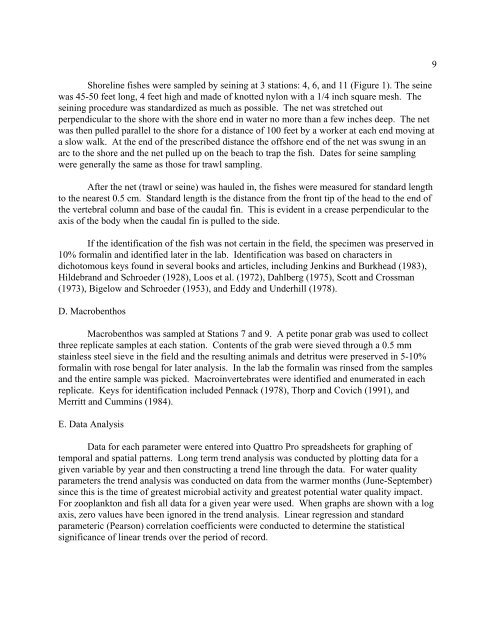NEW: Annual Report - George Mason University
NEW: Annual Report - George Mason University
NEW: Annual Report - George Mason University
Create successful ePaper yourself
Turn your PDF publications into a flip-book with our unique Google optimized e-Paper software.
Shoreline fishes were sampled by seining at 3 stations: 4, 6, and 11 (Figure 1). The seine<br />
was 45-50 feet long, 4 feet high and made of knotted nylon with a 1/4 inch square mesh. The<br />
seining procedure was standardized as much as possible. The net was stretched out<br />
perpendicular to the shore with the shore end in water no more than a few inches deep. The net<br />
was then pulled parallel to the shore for a distance of 100 feet by a worker at each end moving at<br />
a slow walk. At the end of the prescribed distance the offshore end of the net was swung in an<br />
arc to the shore and the net pulled up on the beach to trap the fish. Dates for seine sampling<br />
were generally the same as those for trawl sampling.<br />
After the net (trawl or seine) was hauled in, the fishes were measured for standard length<br />
to the nearest 0.5 cm. Standard length is the distance from the front tip of the head to the end of<br />
the vertebral column and base of the caudal fin. This is evident in a crease perpendicular to the<br />
axis of the body when the caudal fin is pulled to the side.<br />
If the identification of the fish was not certain in the field, the specimen was preserved in<br />
10% formalin and identified later in the lab. Identification was based on characters in<br />
dichotomous keys found in several books and articles, including Jenkins and Burkhead (1983),<br />
Hildebrand and Schroeder (1928), Loos et al. (1972), Dahlberg (1975), Scott and Crossman<br />
(1973), Bigelow and Schroeder (1953), and Eddy and Underhill (1978).<br />
D. Macrobenthos<br />
Macrobenthos was sampled at Stations 7 and 9. A petite ponar grab was used to collect<br />
three replicate samples at each station. Contents of the grab were sieved through a 0.5 mm<br />
stainless steel sieve in the field and the resulting animals and detritus were preserved in 5-10%<br />
formalin with rose bengal for later analysis. In the lab the formalin was rinsed from the samples<br />
and the entire sample was picked. Macroinvertebrates were identified and enumerated in each<br />
replicate. Keys for identification included Pennack (1978), Thorp and Covich (1991), and<br />
Merritt and Cummins (1984).<br />
E. Data Analysis<br />
Data for each parameter were entered into Quattro Pro spreadsheets for graphing of<br />
temporal and spatial patterns. Long term trend analysis was conducted by plotting data for a<br />
given variable by year and then constructing a trend line through the data. For water quality<br />
parameters the trend analysis was conducted on data from the warmer months (June-September)<br />
since this is the time of greatest microbial activity and greatest potential water quality impact.<br />
For zooplankton and fish all data for a given year were used. When graphs are shown with a log<br />
axis, zero values have been ignored in the trend analysis. Linear regression and standard<br />
parameteric (Pearson) correlation coefficients were conducted to determine the statistical<br />
significance of linear trends over the period of record.<br />
9
















